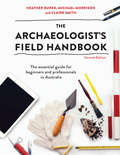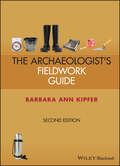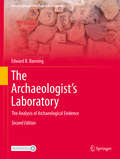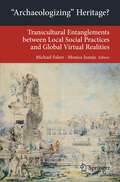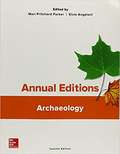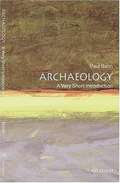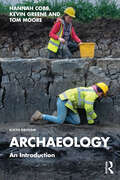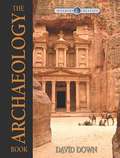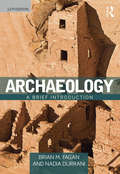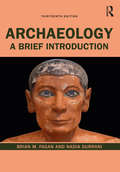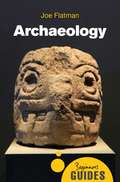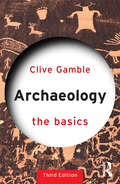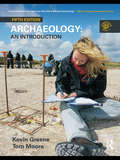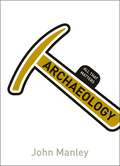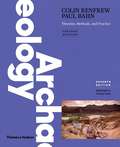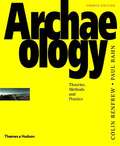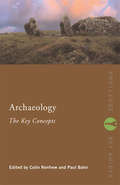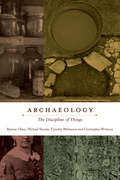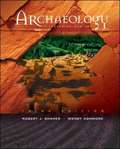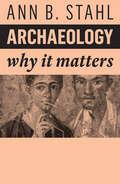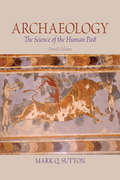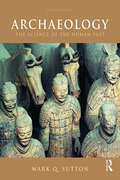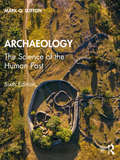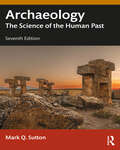- Table View
- List View
The Archaeologist's Field Handbook: The essential guide for beginners and professionals in Australia
by Claire Smith Heather Burke Michael MorrisonIn one volume here is everything you need to conduct fieldwork in archaeology. The Archaeologist's Field Handbook is designed for every kind of archaeological practice, from simple site recordings to professional consultancies and anyone who wants to record heritage sites responsibly.This hands-on manual provides step-by-step instructions on how to undertake and successfully complete fieldwork in all fields of archaeology, from Indigenous to historical to landscape work. Charts, checklists, graphs, maps and diagrams clearly illustrate how to design, fund, research, map, record, interpret, photograph and write up your fieldwork.This second edition is updated throughout and incorporates strategies for digital data capture, improved methods, recent legislation and more affordable technologies for surveying and photography. The Archaeologist's Field Handbook remains the ultimate resource for consultants, teachers, students, community groups and anyone involved in heritage fieldwork.'An essential aid for beginners and professionals.' - Emeritus Professor John Mulvaney'This volume has become the standard for archaeological field training ... A must for students, professionals and community groups.' - Martin Gibbs, Professor of Archaeology, University of New England'It is absolutely the 'go to' field manual for archaeologists whatever their level within the profession.' - Jane Balme, Associate Professor of Archaeology, University of Western Australia
Archaeologist's Fieldwork Guide
by Barbara Ann KipferThe new edition of the most comprehensive, practical, and user-friendly guide of its kind, providing quick reference to the information needed by archaeologists doing fieldwork The Archaeologist's Fieldwork Guide is the must-have companion for anyone planning and performing fieldwork, whether a student going into the field for the first time or a professional archaeologist with years of real-world experience. Designed to be an all-in-one informational toolkit, the Guide is packed with the technical and practical information archaeologists need to know when in the field—supported by more than 400 lists and checklists, planning aids, measurement charts and tables, analysis and classification guides, sample forms, abbreviations and codes, and much more. Fully revised throughout, the second edition features two entirely new chapters on technology in the field and the archaeology laboratory, incorporating current tools and technologies such as geographic information systems (GIS), 3D data capture and modeling, DNA extraction, light detection and ranging (LiDAR) scanning, remotely controlled drones, and underground mapping. New and updated coverage includes flotation samples and processing, oxidizable carbon ratio dating, phytolith sampling, and water screening. Covers classification and typology, creating forms and records, measurement and conversion, laboratory handling and processing, artifact mapping, drawing, and photographing Offers new and updated material on legislation regarding archaeological fieldwork and emerging topics such as community engagement and public archaeology. Provides up-to-date definitions and explanations of key terms and new diagrams, line drawings, and glosses Includes a guide to research publication, an extensive bibliography, references to relevant associations and publications, and information on where to buy suppliesThe Archaeologist’s Fieldwork Guide, Second Edition is an indispensable resource for undergraduate and graduate archaeology students, students taking courses in anthropology, ethnography, and cultural resource management (CRM), archaeology enthusiasts and volunteers, and professional archeologists at any level.
The Archaeologist's Laboratory: The Analysis of Archaeological Evidence (Interdisciplinary Contributions to Archaeology)
by Edward B. BanningThis second edition of the classic textbook, The Archaeologist’s Laboratory, is a substantially revised work that offers updated information on the archaeological work that follows fieldwork, such as the processing and analysis of artifacts and other evidence. An overarching theme of this edition is the quality and validity of archaeological arguments and the data we use to support them. The book introduces many of the laboratory activities that archaeologists carry out and the ways we can present research results, including graphs and artifact illustrations. Part I introduces general topics concerning measurement error, data quality, research design, typology, probability and databases. It also includes data presentation, basic artifact conservation, and laboratory safety. Part II offers brief surveys of the analysis of lithics and ground stone, pottery, metal artifacts, bone and shell artifacts, animal and plant remains, and sediments, as well as dating by stratigraphy, seriation and chronometric methods. It concludes with a chapter on archaeological illustration and publication. A new feature of the book is illustration of concepts through case studies from around the world and from the Palaeolithic to historical archaeology.The text is appropriate for senior undergraduate students and will also serve as a useful reference for graduate students and professional archaeologists.
'Archaeologizing' Heritage?: Transcultural Entanglements between Local Social Practices and Global Virtual Realities (Transcultural Research – Heidelberg Studies on Asia and Europe in a Global Context)
by Michael Falser Monica JunejaThis book investigates what has constituted notions of "archaeological heritage" from colonial times to the present. It includes case studies of sites in South and Southeast Asia with a special focus on Angkor, Cambodia. The contributions, the subjects of which range from architectural and intellectual history to historic preservation and restoration, evaluate historical processes spanning two centuries which saw the imagination and production of "dead archaeological ruins" by often overlooking living local, social, and ritual forms of usage on site. Case studies from computational modelling in archaeology discuss a comparable paradigmatic change from a mere simulation of supposedly dead archaeological building material to an increasing appreciation and scientific incorporation of the knowledge of local stakeholders. This book seeks to bring these different approaches from the humanities and engineering sciences into a trans-disciplinary discussion.
Archaeology
by Elvio Angeloni Mari Pritchard ParkerAnnual Editions: Archaeology has been compiled by its two editors with the intent of presenting a vivid overview of the field of archaeology as practiced today. It is our hope that these readings, in keeping with its previous editions will make the old bones, shards of pottery, and stone tools of the past pop into the present.
Archaeology: A Very Short Introduction
by Paul BahnThis little book is merely intended to whet the appetite by presenting some rudiments of the subject of archaeology in the hope that the reader may be stimulated to delve more deeply into its rich literature, to carry out some research or fieldwork, or, in the case of students, decide to take it up as a university course. You may not find employment at the end of such a course, or even at the end of a Ph.D.; but in these days when even the 'safe' areas like banking no longer guarantee a job for life, you might as well enjoy yourself while you can, and - as the late Glyn Daniel often emphasized - archaeology is nothing if it is not about pleasure. Inevitably you may need to shift and sieve a lot of earth, memorize some boring dates, wrap your tongue round meaningless jargon, and try to grapple with the Sumo wrestlers of theory, but at the same time you will be transported into a world of art and artefacts, temples and tools, tombs and treasures, lost cities and mysterious scripts, mummies and mammoths.
Archaeology: An Introduction
by Hannah Cobb Kevin Greene Tom MooreThis fully updated sixth edition of a classic classroom text is essential reading for core courses in archaeology.Archaeology: An Introduction explains how the subject emerged from an amateur pursuit in the eighteenth century into a serious discipline and explores changing trends in interpretation in recent decades. The authors convey the excitement of archaeology while helping readers to evaluate new discoveries by explaining the methods and theories that lie behind them. In addition to drawing upon examples and case studies from many regions of the world and periods of the past, the book incorporates the authors’ own fieldwork, research and teaching. It continues to include key reference and further reading sections to help new readers find their way through the ever-expanding range of archaeological publications and online sources as well as colour illustrations and boxed topic sections to increase comprehension.Serving as an accessible and lucid textbook, and engaging students with contemporary issues, this book is designed to support students studying Archaeology at an introductory level.New to the sixth edition: Inclusion of the latest survey and imaging techniques, such as the use of drones and eXtended reality. Updated material on developments in dating, DNA analysis, isotopes and population movement, including consideration of the ethical considerations of these techniques. Coverage of new developments in archaeological theory, such as the material turn/ontological turn, and work on issues of equality, diversity and inclusion. A whole new chapter covering archaeology in the present, including new sections on heritage and public archaeology, and an updated consideration of archaeology’s relationship with the climate crisis. A revised glossary with over 200 new additions or updates.
The Archaeology
by David DownDeveloped with three educational levels in mind, The Archaeology Book takes you on an exciting exploration of history and ancient cultures. You'll learn both the techniques of the archaeologist and the accounts of some of the richest discoveries of the Middle East that demonstrate the accuracy and historicity of the Bible.
Archaeology: A Brief Introduction
by Brian M. Fagan Nadia DurraniArchaeology is a jargon-free and accessible introduction to the field which details how archaeologists study the human past in all its fascinating diversity. Now in its twelfth edition, this classic textbook has been updated to reflect the latest research and new findings in the field. Reflecting the global scope of the discipline, the book has a truly international coverage of important discoveries and sites from many corners of the globe. Individual chapters examine archaeology and its history, considering the role of the archaeologist and how they discover, investigate and classify sites and artifacts. This journey through archaeology also includes a discussion of important individuals and groups, and some of the ways in which archaeologists attempt to explain major social and cultural changes in the remote past. Archaeology ends with an outline of the complex world of cultural resource management and gives invaluable advice on how to become an archaeologist. Richly illustrated throughout, this popular and engaging textbook on archaeological methods has introduced generations of students to the captivating world of archaeology.
Archaeology: A Brief Introduction
by Brian M. Fagan Nadia DurraniArchaeology is a jargon-free and accessible introduction to the field which details how archaeologists study the human past in all its fascinating diversity. Now in its thirteenth edition, this classic textbook has been updated to include the latest research and new findings in the field. Reflecting the global scope of the discipline, the book has a truly international coverage of important discoveries and sites from many corners of the globe. Individual chapters examine archaeology and its history, considering the role of the archaeologist and how they discover, investigate and classify sites and artifacts. This journey through archaeology also includes a discussion of important individuals and groups, and some of the ways in which archaeologists attempt to explain major social and cultural changes in the remote past. Archaeology ends with an outline of the complex world of cultural resource management and gives invaluable advice on how to become an archaeologist. Richly illustrated throughout, this popular and engaging textbook on archaeological methods has introduced generations of students to the captivating world of archaeology.
Archaeology: A Beginner's Guide (Beginner's Guides)
by Joe FlatmanArchaeology is more popular than ever. TV and film have made it seem accessible and exciting, and the number of budding amateurs is on the rise, as is government support for archaeological initiatives on a global scale. From coins and combs to battlefields and plantations, archaeologist Joe Flatman provides an incisive introduction to the practice of archaeology. Through comparative case studies he demonstrates how the archaeological mindset reveals unexpected truths about the most modern phenomena. Suddenly a landfill site can expose more about our drinking habits than we may like to admit, and airports become sites as intriguing and complex as the towns and villages they were built over. Flatman also trains his eye on the future and reveals how archaeology can help us predict - and even prevent - the crises that are facing us today.
Archaeology: Trajectories To Early States (The Basics)
by Clive GambleNow in an updated third edition, Archaeology: The Basics provides a straightforward and engaging introduction to the world of Archaeology. This book answers key questions about how and why we practice archaeology and examines the theories and themes underpinning the subject. Fully updated, this new edition includes a wide range of examples and new material on key growth areas including:* Evolutionary approaches in current archaeology* The archaeology of landscape and place* The impact and value of archaeology* Conflict archaeology and the politics of the pastWith 12 new illustrations, four new boxes and additional case studies this text is essential reading for all those beginning to study archaeology and anyone who has ever questioned the past.
Archaeology: An Introduction
by Kevin Greene Tom MooreArchaeology: An Introduction looks behind the popular aspects of archaeology such as the discovery and excavation of sites, the study of human remains and animal bones, radiocarbon dating, museums and 'heritage' displays, and reveals the methods used by archaeologists. It also explains how the subject emerged from an amateur pursuit in the eighteenth century into a serious discipline, and explores changing fashions in interpretation in recent decades. This fifth edition has been updated by a new co-author, Tom Moore, and continues to include key references and guidance to help new readers find their way through the ever expanding range of archaeological publications. It conveys the excitement of new archaeological discoveries that appear on television or in newspapers while helping readers to evaluate them by explaining the methods and theories that lie behind them. Above all, while serving as a lucid textbook, it remains a very accessible account that will interest a wide readership. In addition to drawing upon examples and case studies from many regions of the world and periods of the past, it incorporates the authors' own fieldwork, research and teaching and features a new four-colour text design and colour illustrations plus an additional 50 topic boxes. The comprehensive glossary and bibliography are complemented by a support website hosted by Routledge to assist further study and wider learning. It includes chapter overviews, a testbank of questions, powerpoint discussion questions, web-links to support material for every chapter plus an online glossary and image bank. New to the fifth edition: inclusion of the latest survey techniques updated material on the development in dating, DNA analysis, isotopes and population movement coverage of new themes such as identity and personhood how different societies are defined from an anthropological point of view and the implications of this for archaeological interpretation the impact of climate change and sustainability on heritage management more on the history of archaeology Visit the companion website at www.routledge.com/textbooks/greene for additional resources, including: chapter overviews a testbank of questions PowerPoint discussion questions links to support material for every chapter an online glossary and image bank
Archaeology: All That Matters
by John Manley- When did archaeology begin? - Who were the first antiquarians in early modern Europe? - How did archaeology free human history from biblical creationism? - How did archaeology become a pseudo-scientific discipline? - Who built the first museum? Leading expert Dr John Manley starts by dealing with the processes and techniques used by archaeologists, in the past and today. He then uses the results of famous archaeological studies both to illustrate the power of archaeology, and to show specifically what archaeology has taught us about Roman, Egyptian, ancient, and surprisingly recent, history. In an exciting final chapter, Manley wonders how archaeology may adapt over time, exploring how the archaeologists of the future may examine our own era. Ideal for students or for general reading, this book delivers a thorough and comprehensive introduction to archaeology. All That Matters about archaeology. All That Matters books are a fast way to get right to the heart of key issues.
Archaeology: Theories, Methods, and Practice (Seventh Edition)
by Colin Renfrew Paul BahnSince its first edition, Renfrew and Bahn's Archaeology: Theories, Methods, and Practice has been the leading academic source on what archaeologists do and how they do it. This indispensable book is a comprehensive introduction to archaeology in the field, the laboratory, and the library. Archaeology is organized around the key questions that archaeologists ask about the past and details the practical and theoretical ways in which answers to those questions are sought. The seventh edition has been thoroughly revised and updated to include the newest developments in the subject and the latest discoveries, and is newly designed with additional box features and extensive drawings, charts, and photographs, all in full color.
Archaeology: Theories, Methods, and Practice (4th Edition)
by Colin Renfrew Paul BahnA textbook on archaeology: its history; the variety of evidence; survey and excavation of sites and features; dating methods; social, environmental and cognitive archaeology; 5 case studies, and the archaeology of people.
Archaeology: Theories, Methods, And Practice (Routledge Key Guides)
by Colin Renfrew Paul BahnFrom two of the best-known archaeological writers in the trade, this outstanding resource provides a thorough survey of the key ideas in archaeology, and how they impact on archaeological thinking and method. Clearly written, and easy to follow, Archaeology: The Key Concepts collates entries written specifically by field specialists, and each entry offers a definition of the term, its origins and development, and all the major figures involved in the area. The entries include: thinking about landscape archaeology of cult and religion cultural evolution concepts of time urban societies the antiquity of humankind archaeology of gender feminist archaeology experimental archaeology multiregional evolution. With guides to further reading, extensive cross-referencing, and accessibly written for even beginner students, this book is a superb guide for anyone studying, teaching, or with any interest in this fascinating subject.
Archaeology: The Discipline of Things
by Michael Shanks Christopher Witmore Timothy Webmoor Bjørnar OlsenArchaeology has always been marked by its particular care, obligation, and loyalty to things. While archaeologists may not share similar perspectives or practices, they find common ground in their concern for objects monumental and mundane. This book considers the myriad ways that archaeologists engage with things in order to craft stories, both big and small, concerning our relations with materials and the nature of the past. Literally the "science of old things," archaeology does not discover the past as it was but must work with what remains. Such work involves the tangible mediation of past and present, of people and their cultural fabric, for things cannot be separated from society. Things are us. This book does not set forth a sweeping new theory. It does not seek to transform the discipline of archaeology. Rather, it aims to understand precisely what archaeologists do and to urge practitioners toward a renewed focus on and care for things.
Archaeology: Discovering Our Past, Third Edition
by Robert J. Sharer Wendy AshmoreThis is the only textbook which is organized to follow the steps of the actual process of archaeological research in order to present the methods and theoretical frameworks of archaeology, from the planning and actual conduct of field research, to the different ways archaeological data is interpreted to produce an understanding of the past. It is also the only such textbook to give the reader a series of firsthand accounts of what its like to do archaeology, written by a variety of practicing archaeologists.
Archaeology: Why It Matters (Why It Matters #1)
by Ann B. StahlHistory lies beneath our feet and in the landscapes around us. In contrast to the history that comes from studying texts, archaeology is the study of history through objects, monuments, and other traces of past lives: history that extends beyond the earliest writings into the deep past, revealing the varied pathways that led to the present, and the challenges – often similar to those we face today – that confronted our ancestors. Ann Stahl argues that archaeology is unique in its focus on the everyday lives of all peoples in all places and times. From ancient temples to humble homes, archaeologists piece together worlds that would otherwise be lost: knowledge that shows us how routine actions have shaped societies, how and why societies have changed in light of environment, politics, and culture – and perhaps what the future holds for our societies too. Using compelling examples from a storied international career, Stahl provides the perfect summary of why archaeology is both a vitally important and enjoyable subject to study.
Archaeology: The Science of the Human Past
by Mark Q SuttonIlluminating the world of archaeology. Archaeology conveys the excitement of archaeological discovery and explains how archaeologists think as they scientifically find, analyze, and interpret evidence. The main objective of this text is to provide an introduction to the broad and fascinating world of archaeology from the scientific perspective. Discussions on the theoretical aspects of archaeology, as well as the practical applications of what is learned about the past, have been updated and expanded upon in this fourth edition. Learning GoalsUpon completing this book, readers will be able to: Discuss the theoretical aspects of archaeology. Apply what has been learned about the past. Identify the various perspectives archaeologists have.
Archaeology: The Science of the Human Past
by Mark Q SuttonArchaeology: The Science of the Human Past provides an introduction to the broad and fascinating world of archaeology from the scientific perspective. Conveying the exhilaration of archaeological work, it explores the ways archaeologists analyse and interpret evidence. Varying perspectives are considered to provide holistic coverage of archaeological techniques and methods and show how the complexity of the past can be captured by the empirical science of archaeology. The Fifth Edition has been updated and revised to include the latest archaeological approaches and the impact developments in archaeological science have made in recent years. The chapter on bioarchaeology has been completely rewritten to reflect these developments. Archaeology: An Introduction will allow students to understand the theoretical and scientific aspects of archaeology and how various archaeological perspectives and techniques help us understand how and what we know about the past.
Archaeology: The Science of the Human Past
by Mark Q. SuttonArchaeology: The Science of the Human Past provides students with a thorough understanding of what archaeology is and how it operates and familiarizes them with fundamental archaeological concepts and methods. This volume introduces the basic components of archaeology, including sites, artifacts, ecofacts, remote sensing, and excavation. It discusses how archaeologists obtain and classify information and how they analyze this information to formulate and test models of what happened in the past. Cultural resource management and the laws and regulations that deal with archaeology around the world are described. Archaeology is placed in the context of contemporary issues, from environmental problems to issues affecting Indigenous populations. The sixth edition has been updated and simplified to create a more streamlined volume to meet the needs of the students and teachers for whom it is designed, reflecting the latest developments in archaeological techniques and approaches. Allowing students to understand the theoretical and scientific aspects of archaeology and how various archaeological perspectives and techniques help us understand how and what we know about the past, Archaeology: The Science of the Human Past is an ideal introduction to archaeology.
Archaeology: The Science of the Human Past
by Mark Q. SuttonArchaeology: The Science of the Human Past introduces students to the wide-ranging and fascinating world of archaeology and provides them with a comprehensive understanding of fundamental archaeological concepts and methods.The seventh edition keeps pace with the developments in archaeological science with up-to-date information on dating, artifact analyses, and remote sensing. Theoretical developments in power, gender, and cognition are also included. Introducing the key components of archaeology, including sites, artifacts, ecofacts, remote sensing, and excavation, it discusses the ways archaeologists obtain, analyze, and interpret evidence. Varying perspectives are considered to provide holistic coverage of how archaeological techniques and methods are used to formulate and test models of what happened in the past. Cultural resource management and the laws and regulations that deal with archaeology around the world are described. Archaeology is placed in the context of current topics, from environmental problems to issues affecting Indigenous populations.Archaeology: The Science of the Human Past remains an ideal introduction to archaeology by offering students a broad and clear understanding of the theoretical and scientific aspects of archaeology and how various archaeological perspectives and techniques help us comprehend not just the past but the contemporary world as well.
